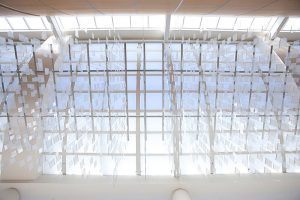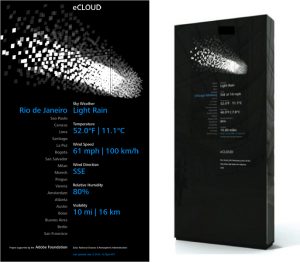As soon as I saw the theme for this week’s Looking Outwards, I immediately knew what I wanted to talk about. There is an art installation between gates 22 and 23 in the San Jose International Airport that I have been walking under and marveling at for about seven years now, but I’ve never looked into how it was actually made or the details of what it represents. This assignment was a great opportunity to do just that.


“eCLOUD” is a dynamic, generative sculpture created to simulate the actual behavior and physical make of a natural cloud. The piece, which stretches 120 feet and hangs suspended from the ceiling, is composed of these specialized polycarbonate tiles that transition between different states of transparency. The degree of opacity is determines by weather patterns from around the world, collected and transmitted in real time to create a cloud that appears the same way one would in that particular time zone.
The random element in this piece is the weather, and I think this is an example of biased but true randomness, since rather than it being a “pseudo-random” quantity generated by a computer, it relied complexity on data from the natural world. And because the algorithm pulls data from around the world and a bunch of different climates, some of the weather bias is avoided because multiple regions are covered.
I love this art piece because of the aesthetics: I think a lot of generative computer art can get wildly technical to the point of losing that “easy beauty” that more traditional fine art has, but their piece is so simplistic yet so complex in build that is satisfies both aesthetic appeal and the technical intrigue of a stand-out installation.
![[OLD FALL 2018] 15-104 • Introduction to Computing for Creative Practice](wp-content/uploads/2020/08/stop-banner.png)